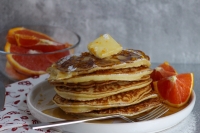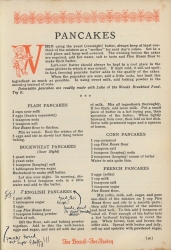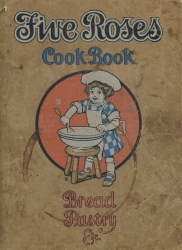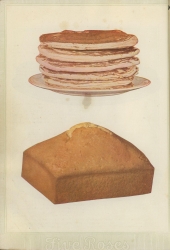
 604 465 4322
604 465 4322General Store Site 12294 Harris Road Pitt Meadows, B.C.
Click Here for Directions& Visiting Hours

English Pancakes 1915
Recipe (Five Roses Cookbook 1915)
Sift the flour, salt and baking powder together. Add to this the well beaten eggs and sugar, and mix all with the pint of milk. Mix all ingredients thoroughly. If too thick, add more milk. Put a small piece of butter in a hot frying pan, then spoonfuls of the batter. (Pancakes turned out super fluffy!). When lightly browned, turn over, then fold on hot dish. Serve with powdered sugar and a squeeze of lemon.
*****
Over a glass of chilled orange juice, a cup of steaming hot coffee, and a tall stack of buttery, fluffy, decadent pancakes drenched in maple syrup, we take pleasure in knowing we can start our mornings with a full stomach. In 1915, this was not the case, where war rationing was at the forefront of every Canadian household. Government control limiting the purchase of high-demand goods compelled Canadians to rely on food grown in their gardens and become more creative with their recipes. Five Roses Cookbook was created during a tumultuous time in Canada but offered knowledge of old techniques, and inspiration to experiment with ingredients, testing each recipe one by one and finding the perfect one to serve to the men coming home from the front.
With WWI starting the year prior and invoking the War Measures Act, the Canadian government gained more power and control over Canada’s involvement in the war and its citizens. Those deemed “enemy aliens” were placed in internment camps, regardless of their establishment in Canada. The Conscription Crisis would follow a few years later, leading to riots in Quebec. 1915 also brought the Second Battle of Ypres, where chlorine gas was introduced, making it the first large-scale chemical attack in modern history. The chlorine burned men’s throats, causing their lungs to fill, essentially drowning them in their own fluids. Many survived by devising a makeshift urine-soaked gas mask over their mouths and noses. This horrific event led to the poem “In Flanders Fields” by John McCrae, a Canadian Army Medical Corps officer. Amid the chaos and brutality, Canadian troops were hoping for a glimpse of relief, waiting eagerly for parcels sent from home. The food rations included tea, sugar, bread, cheese, alcohol, tinned beef, and on occasion, bacon. Very few fresh vegetables and fruit were sent to troops. Food rationing was tough on the body and the spirit, with many dreaming of a small taste of sweet jam or a bite of fluffy pancakes.
Before the soft, pillowy breakfast food became a popular choice to start the day, flapjacks, commonly known as pancakes, can be traced back to ancient civilizations. Earlier versions of pancakes were often made from simple ingredients such as flour, milk, and eggs, all components still traditionally used in pancakes today. During the Middle Ages, pancakes became a staple to serve during religious holidays such as Shrove Tuesday, where many people indulged in pancakes and other sweets before Lent began on Ash Wednesday. This event would later be known as Pancake Day. This tradition continues in many parts of the world, with pancakes being a staple of New Orleans Mardi Gras celebrations. Pancakes for First Nations people were often made with cornmeal, flour and other available ingredients and toppings gathered from the land. French settlers brought the idea of crepes, which are much thinner than the traditional pancake and often filled with jams and savoury fillings. In the 19th century, the pancake format started changing. Now made from a thick batter consisting of flour, eggs, milk, baking powder, a pinch of salt, and the zest of an orange or lemon, and served with pads of butter and sweet, sticky maple syrup harvested from maple trees in the early spring. Different variations of pancakes would soon follow suit, with ingredient additions such as chocolate chips, blueberries, and savoury fillings like ham and cheese. During this time, pancakes became a popular food to celebrate and enjoy throughout the country. To this day, community pancake breakfasts are still an inviting event that brings people together to share a food tradition that dates back centuries.
During the inception of this cookbook, Pitt Meadows underwent significant changes. In 1914, Pitt Meadows became a District in its own right, establishing itself as a small, isolated farming community with fewer than 500 residents. With roads few and rough, Pitt Meadows was bordered by farmland and brush, with access to the only business being the post office and the general store. In May of 1914, approval of the first municipal hall was underway, seeing its completion in September of that year. The Pitt River vehicle crossing was completed and opened to traffic in March of 1915, nine months after the project began. 1915 in Pitt Meadows ended with a battle with Maple Ridge over dyking and drainage and who would absorb the settlers dwelling on the unincorporated territory between them. Matters were resolved in 1916, with Maple Ridge as the victor. At the end of the decade, Pitt Meadows saw its first industry, the establishment of the Pioneer Peat Factory and an influx of vehicles. Although traveling was more accessible, no one made long trips out of Pitt Meadows and instead went to the local general store (currently the Pitt Meadows Museum) for food and other goods that they did not have access to on their farm, maintaining a connection with the town.
Pancakes, enveloped in the sweetness of maple syrup, symbolized simplicity at its core. Simple, fresh, and local ingredients mixed to make a delectable recipe. Passed through centuries of celebrations and taking part in local traditions of sharing, pancakes served as a reminder that we are a community. We can only hope a simple recipe of pancakes could remedy the turmoil of life during the war, providing relief that one day these simple but delicious recipes could once again be shared and enjoyed together.

Pancakes from 1915 recipe

Recipe for Pancakes from 1915

Five Roses Cookbook from 1915

Photograph of pancakes and cake from Five Roses Cookbook 1915





